Cocoa butter is facing issues of supply shortages and high prices due to the unstable production of cocoa beans. As a result, the use of cocoa butter substitute (CBS), made from inexpensive and stable plant-based fats, is being promoted. However, fat bloom caused by polymorphic transition from the β’ form to the β form is also an issue with CBS. In previous studies, our laboratory has clarified that the strain accumulated within crystals is the cause of fat bloom 1),and that strain can be controlled by differences in viscosity. Therefore, in this study, we considered the possibility that other factors could also suppress strain and focus on the composition of CBS as such other factors. We added trilaurin (LLL), a type of triacylglycerol (TAG) that is a major component of CBS. The aim of this study was to compare the behavior of CBS with different compositions by synchrotron radiation X-ray diffraction (SR-XRD) measurements and differential scanning calorimetry (DSC) on CBS with altered compositions.
The mixture of CBS and LLL melted at 55°C was cooled at a rate of 15°C/min and crystallized at 28°C for three days. Subsequently, SR-XRD measurements were performed at the Photon Factory of the High Energy Accelerator Research Organization, and the strain was calculated from the obtained full width(FWHM) at half maximums of diffraction peaks.
The strain accumulated within the crystals was smaller in the samples with added LLL than in those crystallized with CBS alone. This could be attributed to the fact that the composition of the raw materials is close to the congruent melting composition.
